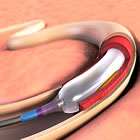|
The IN.PACT SFA Trial enrolled 331 subjects at 57 sites across Europe and the United States. All study subjects were randomized to treatment with the drug-coated balloon (DCB) or percutaneous transluminal angioplasty (PTA). On the key endpoints:
Approximately 650,000 to 700,000 people in the United States and Western Europe undergo an interventional procedure each year for this common form of peripheral artery disease, which typically involves the superficial femoral artery (SFA). The IN.PACT Admiral drug-coated balloon received the CE (Conformité Européene) mark in 2009 but remains an investigational medical device in the United States, where it is under review by the U.S. Food and Drug Administration (FDA). No drug-coated balloon has received FDA approval. Presented at the Charing Cross international symposium for vascular surgeons and interventionalists, results of the IN.PACT SFA Trial will soon be submitted by Medtronic to the FDA as part of the company's application for pre-market approval of the IN.PACT Admiral drug-coated balloon.
"The results of this rigorously conducted randomized controlled trial warrant a review of current treatment guidelines for peripheral artery disease in the lower extremities," according to principal investigator Gunnar Tepe, chief of radiology at RoMed Klinikum in Rosenheim, Germany. "In fact, they should lead to a reconsideration of how we treat patients with claudication, as the highest level of clinical evidence now distinguishes the IN.PACT Admiral drug-coated balloon as a primary therapy for atherosclerosis in the SFA." To ensure data accuracy and reliability, patency endpoints underwent evaluation by an independent imaging core lab, while all clinical events were adjudicated by an independent clinical events committee. To prevent bias, both the imaging core lab and the clinical events committee were blinded to the patients' randomization assignment. Study subjects were well matched at the time of enrollment. The vast majority (approximately 95 percent) of the patients had moderate or severe claudication, a condition characterized by leg pain while walking due to restricted blood flow through the SFA or proximal popliteal artery (both in the leg above the knee). The remaining five percent suffered from rest pain because of more advanced arterial disease. In addition to disease severity, other baseline characteristics -- including diabetes (40.5% vs. 48.6%) and hypertension (91.4% vs. 88.3%), as well as mean lesion length (8.94 cm vs. 8.81 cm) and percent of total occlusions (25.8% vs. 19.5%) -- were also similar between the two groups, with no statistically significant differences. Clinical outcomes, however, significantly favored the DCB group. "Based on the addition of these compelling new data to the positive results of previous studies, we see a path to establishing a new standard of care for SFA disease with an optimized and trusted medical technology," said Tony Semedo, a senior vice president at Medtronic and president of the company's Endovascular Therapies business. "The IN.PACT Admiral drug-coated balloon has the lowest reported revascularization rate of any medical technology for the treatment of SFA disease; and in this particular vessel bed, our device also has the highest reported primary patency rate, with minimal need for durable implants." To date, 24 clinical studies of the IN.PACT Admiral drug-coated balloon involving more than 4,200 patients have been undertaken. Results presented at medical meetings and published in peer-reviewed medical journals consistently show positive patient outcomes with the novel medical device, which is coated with a drug called paclitaxel that prevents excess scar tissue from forming along the wall of the treated arterial segment and leaves no scaffolding behind. Caused by atherosclerotic plaque formation that narrows the arterial lumen and restricts blood flow, peripheral artery disease affects an estimated 50 million people in the United States and Europe. In the legs it frequently results in claudication, a condition characterized by severe pain in calf muscles while walking. More common among men and smokers, claudication has a higher prevalence in the population over age 60. Without effective treatment, claudication can lead to critical limb ischemia, amputation and premature death. In collaboration with leading clinicians, researchers and scientists, Medtronic offers the broadest range of innovative medical technology for the interventional and surgical treatment of cardiovascular diseases and cardiac arrhythmias. The company strives to offer products and services that deliver clinical and economic value to healthcare consumers and providers worldwide. About Medtronic Any forward-looking statements are subject to risks and uncertainties such as those described in Medtronic's periodic reports on file with the Securities and Exchange Commission. Actual results may differ materially from anticipated results. Source: Medtronic, Inc. |


